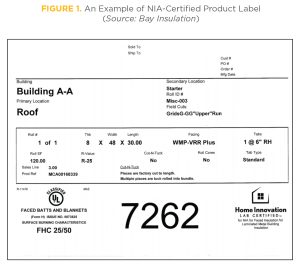NIA Releases an Updated Standard for Faced Metal Building Insulation
One of the key objectives of the NIA’s Metal Building Laminator (MBL) Committee is to develop technical and professional guidelines that will help laminators deliver the highest quality products and services, and to promote these standards within the metal building industry, in conjunction with the North American Insulation Manufacturers Association and other relevant organizations. In adhering to that objective, the MBL Committee decided that the existing NIA-Certified Faced Insulation Standard (Standard) for metal building insulation needed to be reviewed and updated.
A task force was formed to review and recommend changes to the Standard. After several task force meetings with NIA EVP/CEO and NIA Legal Counsel, the group was able to present an updated Standard to the MBL Committee during the October 2022 meeting at Metalcon in Indianapolis, Indiana. Following much discussion, the MBL Committee voted to accept and present the updated Standard to the NIA Board of Directors.
During the NIA Fall Summit at MGM National Harbor in National Harbor, Maryland, on November 3, 2022, the NIA Board of Directors voted to unanimously approve the revised Standard.
What Has Changed in the Standard?
There were two major additions to the Standard:
- Third-Party certification mark on the finished product label for R-value.
- Third-Party certification mark on the finished product label for surface burning characteristics.
What Is Third-Party Certification?
Third-party certification means that an independent organization has reviewed the manufacturing process of a product and independently determined that the final product complies with specific standards for safety, quality, and/or performance. This review typically includes comprehensive formulation/material reviews, testing, and facility inspections. Certified products will bear the certifier’s mark on the laminator’s packaging to give buyers confidence that the product will meet any claims made by the laminator.
R-Value
In 1979, The Federal Trade Commission (FTC) established what is known as the R-Value Rule, or FTC 16 CFR Part 460. This rule establishes the criteria for claims regarding the R-value of insulation products. It is important that industry consumers have confidence that the R-value stated on our products meets the R-value of the product in that package.
The updated Standard now states that metal building insulation laminators must use an independent, third-party laboratory to test, monitor, and certify their products. Additionally, the third-party lab’s certification mark must also be present on the product label.
Surface Burning Characteristics
All products that are used within a building envelope are subject to scrutiny by various building codes. In particular, the International Building Code, International Mechanical Code, Uniform Mechanical Code, and the National Fire Protection Agency all have specific requirements for products related to their surface burning characteristics—i.e., the flame spread and smoked developed values of the product.
To qualify for the updated Standard, metal building insulation laminators must use an independent, third-party laboratory to test, monitor, and certify the resulting surface burning characteristics of their products. After doing so, the laboratory’s certification mark, along with the “Flame Spread and Smoke Developed” rating of the product, must be present on the product label.
It should be noted that the Standard is not a mandatory requirement for metal building laminators. It is voluntary. Each laminator of faced metal building insulation must decide whether they will or will not comply with the Standard and undergo third-party testing.
Where Can the Updated NIA-Certified Faced Insulation Standard Be Found?
As of January 2023, the updated Standard will be available free to all. You will find it on the NIA website at www.insulation.org.
What Do Building Owners/End Users Need to Know or Ask for?
End users should ask their supplier if the metal building insulation they are purchasing is NIA-certified faced insulation that meets the updated standard. The best way to know is if the product’s label lists R‑value, flame spread/smoke developed values, and have the certifications marks of the third-party labs for both R-value and surface burning characteristics.
There are various independent, third-party laboratories that certify insulation products. Figure 1 shows just one example of a faced metal building insulation label that meets the updated Standard. This example has the R-value certification by Home Innovations Lab and surface burning characteristics certification by Underwriters Laboratories, showing a flame spread/smoked rating of Fire Hazard Classification (FHC) 25/50.


